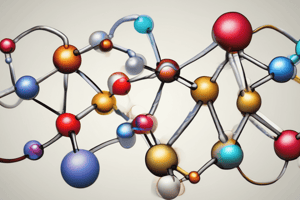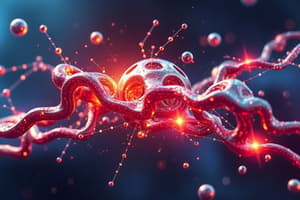Podcast
Questions and Answers
What is the primary bond type present in a quintuple bond?
What is the primary bond type present in a quintuple bond?
- One sigma bond, two pi bonds, and two delta bonds (correct)
- Four pi bonds and one sigma bond
- Two sigma bonds and three pi bonds
- One sigma bond, three delta bonds
What is the Re-Re distance in Re metal?
What is the Re-Re distance in Re metal?
275 pm
All quintuple bond complexes utilize monodentate ligands.
All quintuple bond complexes utilize monodentate ligands.
False (B)
Match the following bond types with their characteristics:
Match the following bond types with their characteristics:
The configuration of a metal-metal triple bond can be described as ______.
The configuration of a metal-metal triple bond can be described as ______.
What is the total number of metal-metal bonds in Co4(CO)12?
What is the total number of metal-metal bonds in Co4(CO)12?
The total valence electrons in [η5-CpMo(CO)2]2 is 30.
The total valence electrons in [η5-CpMo(CO)2]2 is 30.
What is the electron count per metal for Fe3(CO)12?
What is the electron count per metal for Fe3(CO)12?
The bonding in Ti(BH4)3(PMe)2 involves a bidentate _______ ion.
The bonding in Ti(BH4)3(PMe)2 involves a bidentate _______ ion.
How many total metal-metal bonds are present in Ir4(CO)12?
How many total metal-metal bonds are present in Ir4(CO)12?
Match the following compounds with their total valence electrons (TVE):
Match the following compounds with their total valence electrons (TVE):
The C-H bond energy is approximately 500 kJ/mol.
The C-H bond energy is approximately 500 kJ/mol.
What is the main functionalization sequence of hydrocarbons?
What is the main functionalization sequence of hydrocarbons?
Study Notes
Arrhenius Equation and Coalescence Temperature
- Published in J.Am.Chem.Soc. in 1971, detailing temperature-dependent behavior of chemical reactions.
Metal-Metal Multiple Bonds
- Significant focus on M-L (metal-ligand) bonding for molecular interactions.
Metal-Metal Quadruple Bond
- Rhenium (Re) exhibits a unique bond with Re-Re distance of 275 pm.
- Out-of-plane distance for Re is 50 pm from four chloride atoms, highlighting geometric arrangement.
Metal-Metal Triple Bond
- Characterized by configuration σ²π⁴δ²δ*², showcasing electronic structure diversity.
Metal-Metal Quintuple Bond
- Cautiously referred to as 5-fold bonding, characterized by σ²π⁴δ⁴ configuration.
- Involves one sigma bond, two pi bonds, and two delta bonds, derived from specific d-orbital mixing.
- In Cr(I) complexes, the Cr…Cr distance measures 183.5 pm, while the quadruple bond measures 236.9 pm.
- All quintuple bond complexes contain bidentate bridging ligands, acting as molecular "tweezers" to minimize distance between metal centers.
Metal-Metal Bond Calculation for Complexes
-
Fe₃(CO)₁₂:
- Total valence electrons (TVE) = 48
- Difference (B) = 6, leading to 3 total M-M bonds.
- Electrons per metal center calculated as 16.
-
Co₄(CO)₁₂:
- TVE = 60, B = 12 results in 6 total M-M bonds.
-
[η⁵-CpMo(CO)₂]₂:
- TVE = 30, B = 6 leading to 3 total M-M bonds.
Hoffmann’s Symbol and Mechanisms
- Noted for unknown exact mechanism in certain reactions, emphasizing chemical complexity.
Oxidative and Reductive Elimination
- Reaction involving titanium hydride with ethereal interaction from bidentate and monodentate borohydride ions.
Distorted Trigonal Pyramidal Geometry
- Resultant geometry from complex formation of Ti(BH₄)₃(PMe)₂, showcasing multifunctional ligand interactions.
Hydrocarbon Functionalization Sequence
- Initiates with alkane coordination, followed by potential decarbonylation processes.
Titan (Moon of Saturn) Insight
- Features a liquid methane sea, bringing astrobiological and geochemical interest to extreme environments.
Studying That Suits You
Use AI to generate personalized quizzes and flashcards to suit your learning preferences.
Related Documents
Description
Explore the fascinating concepts of metal-metal bonding, including multiple and quadruple bonds in transition metals. This quiz also delves into the Arrhenius equation and its application in chemical thermodynamics. Test your understanding of these advanced topics from the field of inorganic chemistry.




